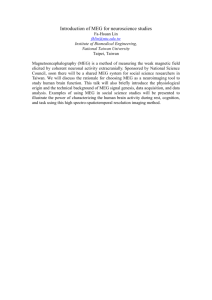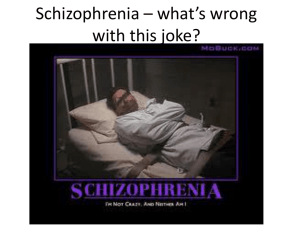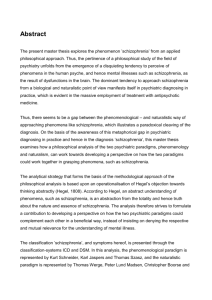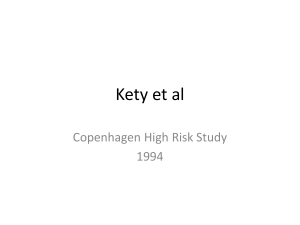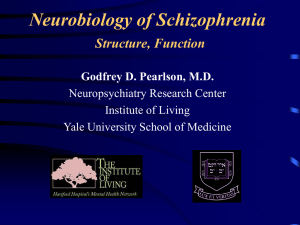Potential Diagnosis and Treatment of Schizophrenia using
advertisement
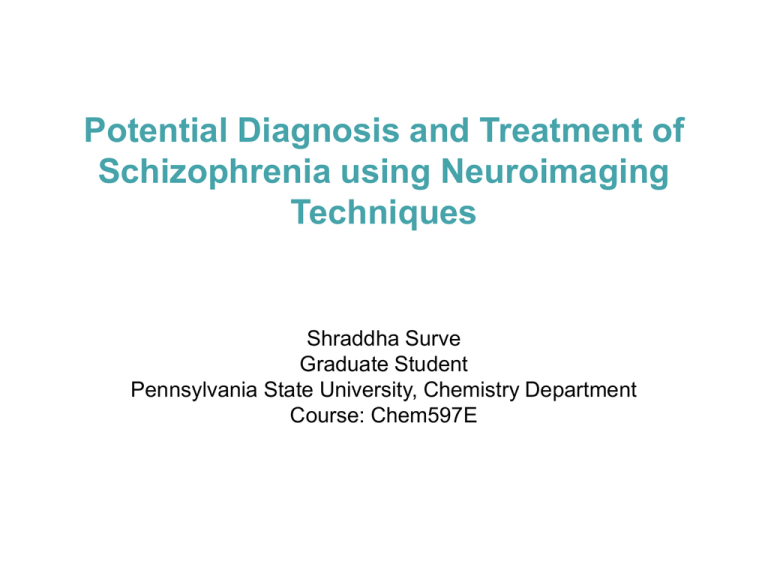
Potential Diagnosis and Treatment of Schizophrenia using Neuroimaging Techniques Shraddha Surve Graduate Student Pennsylvania State University, Chemistry Department Course: Chem597E What is Schizophrenia? • Chronic, severe, and disabling brain disorder • Affects around 1% of human population worldwide • Patients may hear weird voices, believe that others are reading their minds, controlling their thoughts, or plotting to harm them • Causes fearfulness, withdrawal, or extreme agitation Signs and Symptoms Cognitive symptoms Positive Symptoms Negative Symptoms • Unusual thoughts • Loss or decrease or perceptions in ability to initiate plans, • Hallucinations speak, express emotion. • Disorders of movement • Harder to recognize • Problems with attention, certain types of memory and executive functions. • Sometimes difficult to recognize • Cause the most problems Diagosis Methods: • Currently no laboratory test for detecting schizophrenia • Diagnosis is made by clinical examination of things like: Person's family history Emotional history Current symptoms Presence of other disorders (differential diagnosis) • Not a foolproof method • Subjective evaluation of the disease • Exact stage of the disease cannot be specified Brain Imaging • Functional MRI (fMRI) • Positron Emission Tomography (PET) • Single Photon Emission Tomography (SPECT) • Magnetoencephalography (MEG) Why brain imaging? • Neuropsychiatric and neurodegenerative illnesses have strong genetic component • Brain development and function have strong genetic influences • Mental illness should be reflected in brain function and therefore by imaging techniques • Quantitative and qualitative changes in brain function often precede clinical changes, and thus, can be important in early diagnosis and monitoring of treatment fMRI • Non-invasive • Crucial point: brain function is spatially segregated • BOLD (Blood Oxygenation Level Dependent) signal change • Principle: Deoxyhemoglobin High spin state of heme ion Paramagnetic Oxyhemoglobin Digital images portraying neural activity as ratio Oxyhemo: Deoxyhemo Blood oxygen level dependent signals Low spin Dimagnetic • Studies have already been performed on mice using fMRI. • Image is from UCLA Laboratory of Neuro Imaging • After repeatedly scanning 12 schizophrenic patients over five years, and comparing them with matched 12 healthy controls, scanned at the same ages and intervals. • Severe loss of gray matter is indicated by red and pink colors, while stable regions are in blue. • STG denotes the superior temporal gyrus, and DLPFC denotes the dorsolateral prefrontal cortex Positron Emission Tomography (PET): • Chemical substance labelled, usually O15 injected into the body in the form of radioactive water. • Radiotracer emits positrons, which collide with electrons generating two photons travelling in opposite direction • Areas of the brain that are working relatively harder get increased blood flow. This results in more labeled oxygen migrating to these areas. Single-Photon Emission Computed Tomography (SPECT) • Patient is treated with a radioactive substance that releases individual gamma rays in small amounts • Some of these gamma rays are detected by a special cameras. • The tracer generally used: 99mTc-HMPAO (hexamethylpropylene amine oxime). • 99mTc: metastable nuclear isomer which emits gamma rays. • When it is attached to HMPAO, this allows 99mTc to be taken up by brain tissue in quantities proportial to brain blood flow, thus making it possible to assess brain blood flow with the nuclear gamma camera. Magnetoencephalography (MEG) • Measures magnetic fields produced by electrical activity in the brain via extremely sensitive devices. • Superconducting quantum interference devices (SQUIDs) • Direct measure of brain function • MEG allows upto the order of millisecond processing. Magnetoencephalography (MEG) • Excellent spatial resolution: Sources can be localized with millimeter precision. • Earlier techniques: limitation of their temporal and spatial resolution and in their reliance on brain metabolism and hemodynamics. • MEG does not require the injection of isotopes or exposure to X-rays or magnetic fields. • Children or infants can be studied and repeated tests are possible without side effects. • A drawback: Signals are extremely small, several orders of magnitude smaller than other signals in the environment that can obscure the signal. Specialized shielding is required to eliminate the magnetic interference. Treatment of Schizophrenia and Drug Discovery • Antipsychotic drugs which act as antagonists of central dopamine D2 receptors • Clozapine: drug licenced for the treatment of schizophrenia. • Tolerability for the drugs is poor • Neuroimaging: Better understanding of the mechanism of action of drugs. • PET and SPECT have shown that the efficacy of antipsychotic drugs is related to the occupancy of straital D2 receptors of around 70% • Clozapine also acts as antagonist at serotonin 5-HT receptors and as agonist at dopamine D1 and muscarinic M1 and M4 receptors • Several genes with small effects are believed to be involved • Neuroimaging: Examining how a particular gene is influencing brain functions by monitoring and comparing brain activities in people having both presence and absence of the risk variant of the gene. Conclusion • Neuroimaging is just about beginning to play a promising role • Goal is to understand the complex mechanisms of the disease and thereby develop novel treatments for the same. • Schizophrenia to be identified at early stage, thus preventing the onset of severe symptoms. • Current techniques need to be modelled to suit the diagnosis of factors believed to be involved in causing schizophrenia. • Better methods need to be developed for studying the different neurotransmitter systems. • This can be effectively done by integrating the knowledge of the electronic systems and their capabilities with biological needs. Thank you!
